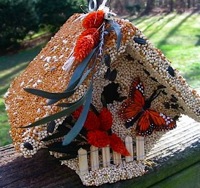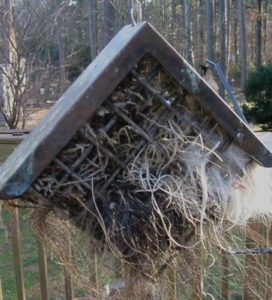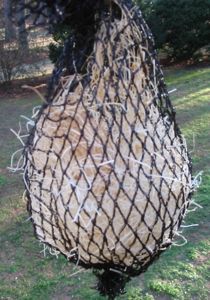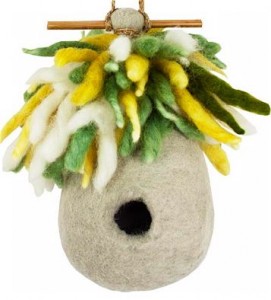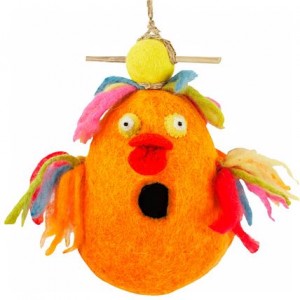-
encourage birds to nest in that edible birdhouse after the party’s over!
So all the food’s gone and the party is over, right? Nope… the fun is just start starting with spring not too far off! And if anything like last year, spring will again come early 🙂
Although it makes an awesome feeder, the All Season’s Wren Casita edible birdhouse is the perfect nest site-for more than just wrens. Some folks have inquired how to re-seed them for extended use as feeders. I suppose peanut butter might work as a good base… but the manufacturer sure isn’t giving away their secret so fast!
So just how does one encourage nesting? It’s all about habitat, so start by offering a fresh water source. No fancy-pants birdbath needed, (unless you’d like one in your yard) something as simple as a plant saucer filled with water works great. On the deck, step, rail, tree stump…wherever! Drill three holes in the sides of a plastic one and make a quick hanging bath should ground predators lurk in your yard (cats). Optimal depth is just 2-3 inches for birds to bathe and wade comfortably. If your dish or saucer is deeper, consider a large rock in the center for birds to perch, or lining the bottom with river rock, or a few layers of pebbles.
Next… nesting materials! Again, you can do this one yourself, no fancy store-bought kits necessary (but we do offer some cool ones). Figure out a vessel to hold the materials; a suet cage works great, as does a mesh produce bag from the grocery store (like the kind apples come in). Then start to gather the goods! Some favorites include:
- Decorative mosses like Spanish, sphagnum, green sheet moss, raffia, and that dried straw stuff. Pluck some from one of your house plants!
- Feathers are adored by tree swallows, and bluebirds have been known to add a few here and there as well. Really cheap at a craft store, or any un-dyed feather duster will do-preferably clean.
- Bright cotton yarns, save these from anywhere you can
- Pet hair is huge favorite of chickadees, titmice, wrens and others. (Not recommended if treated with flea/tick medication)
Live anywhere near a horse farm? Horse hair is the best, and we give it away in the spring! The key is to get the materials out before nesting season actually starts. That way birds see it and become familiar, knowing that when it’s time, the goods are right there for the pickins! Avoid placing materials in any birdhouses as avian amigos prefer to do their own decorating! Simply hang from a branch where they’ll see it. Also, don’t pack the vessel too tightly, as you’ll want the materials to dry quickly after a rain shower.
Offering nesting materials will absolutely encourage nest building around your yard, and extend the use of that edible birdhouse!
Thanks for housing the birds 🙂
-
fun peanut bird feeders do more than peanuts
Since variety is considered the spice of life, try offering birds something a little more exciting than just plain old seed. You’ll attract a broader range of species in the process too.
Peanuts! Jays, Nuthatches, chickadees, woodpeckers and more love peanuts. Shelled or whole, they’re a special treat packed with nutritional value for feathered friends – which makes them a great choice for winter feeding. Birds won’t mind them at all in summer though!
This fun wreath peanut feeder features a mod design resembling an old slinky. In powder coat metal, it won’t rust and squirrels can’t chew through it either. There’s a trick to filling this feeder because it takes two hands, so here’s a quick tip: Sit down, and brace the feeder between your legs. This allows for the two-handed action required for pouring them from the bag, otherwise peanuts end up all over the floor. Been there, and done that!
The cool thing about the wreath, or coil design is the options it affords for your birds. In summer, fruit is a perfect choice to attract migratory birds. Apple, pear, or orange slices, and even grapes are wonderful choices for cat birds, orioles, tanagers, woodpeckers and others.
Early spring is absolutely the best time for offering nesting materials too… and so simple with this peanut bird feeder! Bright cotton yarns, decorative mosses, feathers, and even pet hair are a few favorites that will encourage nest building around the yard. Just fill the wreath, pull some materials through to get started, and hang it from a branch where birds will see it. Don’t pack materials too tightly though. Should rain saturate them, you’ll want enough air to pass through enabling the materials to dry fairly quickly.
Even when using as a peanut feeder, you can still “mix it up” by adding suet balls or suet chunks in with peanuts. Birds will love it, and they’ll be back for more!
By the way, this photo was taken in our backyard, so when it shows up other places… please remember you saw it here first. This is how we ship them, assembled, filled and ready to go, with extra peanuts too!
- Bird Accessories, Bird Houses, Bird Nesting Materials, Decorative Bird Houses, Nesting Material, Uncategorized, Unique Birdhouses, Wood Birdhouse
Made from wool? Yes, wool… not wood birdhouses
While scouring the Atlanta Market in early January, we thought these birdhouses were just too cool! After looking at a gazillion wood birdhouses, is was like “what the heck… wool birdhouses?”
They were so darn cute, but were they functional like wood birdhouses? Yes, because wool naturally sheds rain. You can provide a real nest site (and killer, unique gift) with these fun & functional wool birdhouses!
Handcrafted from felted wool and hand-died yarns, they’re made with sustainably harvested materials including sheep wool, hemp and bamboo. And, these fun hand-felted wool birdhouses are created by skilled, Fair Trade artisans in Katmandu, Nepal, supporting both urban and village women
.
If the surface gets wet it will easily air dry, they can be used indoors for a whimsical accent, or outside where birds can make a home to raise their young. Another really cool thing is that some birds will even snag the colorful fibers to build their own nests, and with the mild winter temps, nesting season is already upon us here in the Southeast.
The 1.25-inch entrance will accommodate chickadees, titmice, wrens, and other small cavity dwelling songbirds. These amazingly cute birdhouses are designed for year-round outdoor use, and will maintain their shape for at least one year, with a longer life span if hung in a sheltered area. The bright colors may begin to fade if left in direct sun for more than two months. They’re a pretty generous size too, measuring 8.5 inches tall by 5.5 wide.
We can’t wait to hang one in our yard (they’re on their way now) and see who takes up residence, and see which birds enjoy feathering their nest with the bright yarns!

